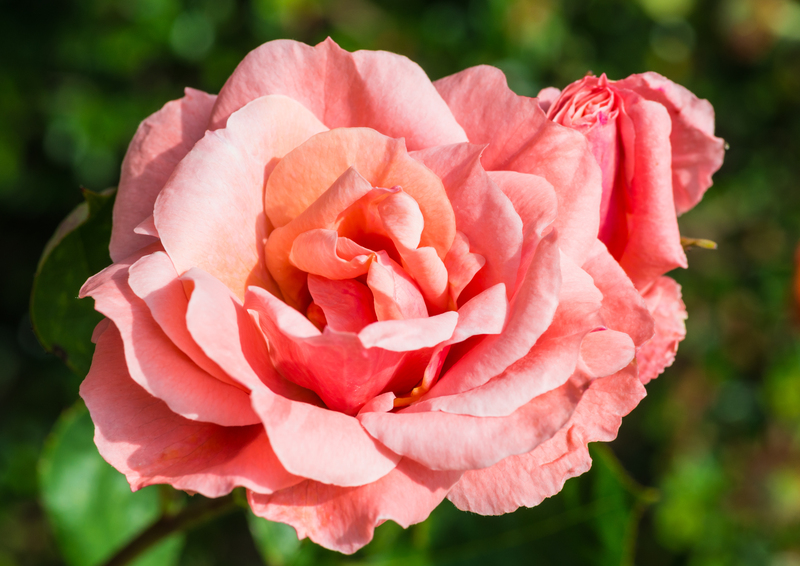Creative Hedge Trimming Approaches for Gardens
Posted on 27/08/2025
Creative Hedge Trimming Approaches for Gardens
Gardens are vibrant, living canvases where homeowners and landscapers can express creativity, personality, and style. Among the diverse elements that contribute to a garden's character, hedges stand out not only as natural boundaries or privacy screens but also as opportunities for artistic expression. Creative hedge trimming approaches can elevate your landscape from ordinary to extraordinary, breathing new life into your outdoor space. This article delves deep into innovative hedge shaping methods, inspiring hedge trimming designs, and expert tips for gardeners seeking to transform their greenery with flair.

Why Get Creative with Your Hedge Trimming?
- Aesthetic Appeal: Unconventional hedge designs catch the eye and provide a unique visual signature for your garden.
- Personal Expression: Artistic trimming allows homeowners to reflect their own style and interests through botanical means.
- Wildlife Support: Some creative shapes can enhance shelter for birds, insects, and small mammals in your garden.
- Functional Art: Shaped hedges can serve practical purposes, such as windbreaks, mazes, or privacy screens, while still looking stunning.
Let's explore a range of innovative hedge trimming techniques and how you can incorporate them into your landscape.
Popular and Artistic Hedge Trimming Styles
1. Traditional Geometric Shapes
This approach is the foundation of many creative hedge trimming designs. Classic shapes such as cubes, rectangles, domes, and spheres lend a sense of order and elegance to formal gardens. If you are new to shaping, starting with simple geometric hedges is a great way to build your skills with shears or electric trimmers.
- Box Hedges: Ideal for garden borders or defining walkways.
- Globe Hedges: Rounded forms soften corners and add a playful touch.
- Pyramid or Cone Shapes: Striking accents for entryways or focal points.
2. Topiary Art - Sculptural Mastery
Taking geometric forms further, topiary hedge trimming is the practice of carefully sculpting bushes and trees into intricate, often whimsical shapes. Topiary art ranges from simple spirals and animal figures to fantastical creatures or even abstract designs.
- Animal Shapes: Rabbits, birds, and even elephants are popular themes.
- Spirals & Obelisks: Add dramatic emphasis along garden paths.
- Themed Scenes: Create storybook scenarios or living scenes for seasonal events.
*Tip: Begin designing with wire frames or stencils until you gain confidence in freehand trimming.*
3. Wavy and Flowing Hedges
Wave-formed hedges break free from the rigidity of straight lines, introducing gentle movement and rhythm into the garden. Wavy hedges look especially stunning along driveways, borders, or fences, creating a sense of motion.
- Undulating Waves: Ideal for long stretches, such as driveway borders.
- Layered Ripples: Multiple tiers of wave patterns give depth and intrigue.
4. Vertical Walls & Living Screens
Modern gardens often feature tall, upright living hedge fences that create privacy and reduce wind. Get creative by adding windows, arches, or cut-out shapes within these vertical hedges.
- Hedge Arches: Natural gateways to different sections of the garden.
- Green Windows: Trimmed shapes that frame special views or sculptures.
5. Mosaic and Patchwork Patterns
For the advanced gardener, mosaic hedges involve planting two or more species or color varieties and trimming them into contrasting patterns--such as checks, diamonds, or stripes. The result is a visually dynamic, living tapestry!
Essential Tools for Creative Hedge Trimming
Embarking on artistic hedge trimming requires more than basic garden shears. For the best results, invest in quality tools designed for both precision and comfort. Here are some essentials for your toolkit:
- Hedge Shears: For shaping straight lines and basic geometric forms.
- Topiary Shears: Precision snips great for intricate work and small figures.
- Electric or Battery Trimmers: Quickly handle large surface areas.
- Pruning Saws & Secateurs: Remove thick branches or rejuvenate overgrown hedges.
- Wire Frames & Stencils: Aid in crafting complex shapes by giving you a guide.
- String Lines & Stakes: Keep your edges straight and symmetrical.
- Protective Gear: Gloves, goggles, and ear protection ensure safe trimming, especially when using power tools.
Regular tool maintenance--sharpening blades and cleaning after use--guarantees crisp cuts and healthy hedges.
Best Plant Choices for Artistic Hedge Designs
Not all hedge varieties respond equally well to shaping and frequent trimming. For successful creative hedge design, choose species with dense growth, small leaves, and robust regrowth. Here are some top candidates:
- Boxwood (Buxus sempervirens): The classic topiary plant. Tolerates heavy shaping and maintains dense foliage.
- Yew (Taxus baccata): Responds well to repeated trimming; long-lived and versatile.
- Privet (Ligustrum spp.): Fast-growing and forgiving--great for beginners.
- Lonicera nitida (Shrubby Honeysuckle): Fine leaves and flexible branches suit detailed designs.
- Photinia, Holly & Cotoneaster: For color variation, flowers, or berries in your hedge patterns.
*For mosaic hedges, mix contrasting leaf colors and textures for a standout effect.*
Step-by-Step: How to Get Started with Creative Hedge Trimming
- Plan Your Design: Sketch your desired shape on paper, considering the plant species, growth rate, and available space. Visualize how the hedge will look in different seasons.
- Mark Your Hedge: Use stakes, string, or chalk lines as guides for straight lines. For curved or intricate shapes, wire frames or cardboard stencils provide a reliable template.
- Trim in Stages: Don't try to achieve the final form all at once. Trim a bit at a time, stepping back regularly to inspect your progress. Young hedges may take several seasons to develop complex shapes.
- Maintain Regularly: Artistic hedges need consistent upkeep. Light trimming every few weeks during the growing season keeps lines sharp and encourages bushy growth.
- Think Three-Dimensional: As your confidence grows, experiment with sculptural details--multiple levels, holes, arches, and even connected figures.
- Care for Plant Health: Water, feed, and mulch your hedges to support dense, healthy foliage. Promptly remove any diseased or dead branches.
Seasonal Tips for Creative Hedge Shaping
The best time for hedge trimming depends on the species. In general:
- Evergreen Hedges: Late spring to early summer, after birds have finished nesting, is ideal.
- Deciduous Hedges: Trim just after flowering or in late winter before new growth starts.
Fertilizing and Care for Artistic Hedges
- Mulching: Keeps roots cool and moist, reducing weed competition.
- Feeding: Balanced, slow-release fertilizers in the growing seasons encourage new, dense shoots.
- Pest Control: Monitor for pests like scale, aphids, or mites--healthy hedges resist damage better.
Troubleshooting Common Hedge Art Challenges
- Uneven Growth? Adjust feeding, watering, and sunlight access. Sometimes shaded areas need selective thinning out of overhead branches.
- Gaps in Foliage? Target light pruning to stimulate dormant buds. In severe cases, replant sections with new cuttings of your chosen species.
- Sparse Lower Growth? Trim the top narrower than the base to allow sunlight to reach the lower leaves, maintaining a dense, green hedge from top to bottom.
- Trimming Mistake? Don't panic! Hedges are forgiving. Allow time for regrowth, adjust your plan, or integrate the error into a new creative feature.
Inspiring Real-Life Examples of Creative Hedge Trimming
Draw inspiration from public gardens, historical estates, and contemporary landscapes around the globe. Famous examples of hedge sculpting mastery include:
- Levens Hall, UK: Home to some of the world's oldest and most intricate topiary art.
- Marqueyssac Gardens, France: Flowing, organic boxwood shapes in a mesmerizing maze layout.
- Private Gardens Worldwide: Many homeowners now showcase stunning hedge sculptures and creative privacy screens, bringing artistic flair to suburban spaces.
The rise of garden social media platforms means it's never been easier to find creative shrub trimming ideas. Search for hashtags like #hedgeart or #topiarydesign for fresh inspiration!
Environmental and Ecological Benefits of Garden Hedge Art
- Wildlife Habitat: Varied, creative hedge layouts often provide niches for birds, pollinators, and small mammals.
- Microclimate Creation: Hedges shape wind, shade, and moisture conditions within your garden.
- Noise and Pollution Reduction: Dense, multi-layered plantings absorb sound and filter dust from busy streets.

Frequently Asked Questions on Creative Hedge Trimming
How often should I trim creative hedges?
The frequency depends on the plant species, climate, and growth rate. Typically, detailed shapes benefit from lighter trims every one to four weeks during the growing season, with less frequent maintenance in winter.
Can any hedge plant be trimmed creatively?
Most dense, small-leaved species respond well, but avoid using plants with large leaves, brittle branches, or slow regrowth. Fast-growing, flexible shrubs are best for artistic hedge sculpting.
How do I fix trimming errors in a creative hedge?
Patience is key! Allow time for regrowth, use formative pruning to guide new shoots, and integrate "mistake" shapes into a new design if possible.
Are there eco-friendly ways to manage hedge clippings?
Absolutely. Fine clippings can be used as mulch, composted, or left as habitat "nests" for garden wildlife.
Conclusion: Transform Your Garden with Artistic Hedge Trimming
Creative hedge trimming is more than just a gardening chore--it's a form of living sculpture that weaves beauty, function, and personality throughout your landscape. Whether you choose classic geometric forms, daring topiary, or contemporary flowing lines, the only limit is your imagination. With the right tools, thoughtful plant selection, and consistent care, anyone can master inventive hedge trimming methods and craft a unique outdoor masterpiece.
Start small, dream big, and let your garden hedges become a testament to your creativity--one trim at a time.

